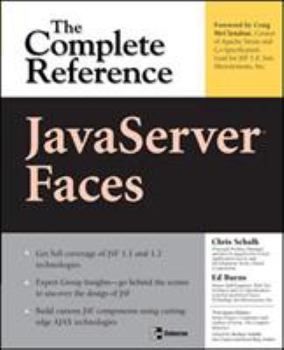JavaServer Faces: The Complete Reference
Select Format
Select Condition 
Book Overview
Publisher's Note: Products purchased from Third Party sellers are not guaranteed by the publisher for quality, authenticity, or access to any online entitlements included with the product.
Ideal for the 3+ million Java developers, this fast-paced tutorial offers in-depth coverage of JavaServer Faces (JSF) -- Sun Microsystem's Web application architecture for the future. Co-written by the #1 JSF expert in the Java community, this book offers...
Format:Paperback
Language:English
ISBN:0072262400
ISBN13:9780072262407
Release Date:September 2006
Publisher:McGraw-Hill Companies
Length:864 Pages
Weight:3.20 lbs.
Dimensions:1.8" x 7.4" x 9.1"
Customer Reviews
5 ratings
This is how a tech book should be written.
Published by Thriftbooks.com User , 16 years ago
As background, before reading this book I had many years of web development experience, including a few years of Struts and ASP.NET development. This book is not simply a reference, as it starts off as a programmers' guide. The book begins with a "hello, world" type of application. Where it shines is in giving very specific instructions for getting that simple application up and running - such as what jar files to download and where to put them. From there, trying out the examples on your own is very simple. The book is very well organized, and thorough. After covering the basics of JSF, it gets into the gory details of writing your own JSF components. It then provides a reference of the standard JSF components and the MyFaces components. One minor complaint is that some of the text covering the basics is verbose and somewhat redundant. But, if you are new to web development and the Model-View-Controller pattern, the wordiness might be helpful. Very well done.
Complete reference JSF book review
Published by Thriftbooks.com User , 16 years ago
Very good book for novice and professionals, the book provide all details about JSF framework programming !!!
Very good book, its deep and explains very good
Published by Thriftbooks.com User , 17 years ago
The book goes over all the stuff in JSF and explains in a very clear language exactly whats happening under the hood of JSF. I have also some other JSF books and this is by far the best.
The most comprehensive JSF coverage so far!
Published by Thriftbooks.com User , 17 years ago
I really enjoyed reading this book. I have several JSF books, and I feel that most of them were rushed to the market. This one is an exception. The coverage is very comprehensive (the book is written by the spec lead), JSF 1.2 is extensively discussed. The book covers multiple open-source "sub-frameworks" for JSF such as Shale and Facelets as well as various component libraries. JSF is a relatively complex framework, and one does need a good reference to be able to master it. I think this book is it.
Excellent Book (from review on TheServerSide.com)
Published by Thriftbooks.com User , 18 years ago
JavaServer Faces: The Complete Reference, by Chris Schalk and Ed Burns, is a once-and-for-all reference to JSF 1.1 and 1.2, covering almost anything and everything JSF-related. Differences between JSF 1.1 and 1.2 are noted whenever they might occur. The book also has some very helpful and interesting design notes from the specification group to enlighten readers of why some choices were made or not made, so that the reasoning behind decisions is exposed. The book has five sections: an introduction to the framework, extending JavaServer Faces, applying JSF (which addresses security, i18n, and testing/debugging), JSF tools and libraries (with coverage of the standard component library, the MyFaces JSF implementation, and configuration files), and a set of appendices covering the Faces Console (a third-party tool to help configure JSF), Shale, migration from Struts, and a set of third-party component libraries. The first section starts off with a history of JSF, and quickly launches into an application - a simple registration application, complete with error checking, data validation, navigation, and a working UI. Along the way, the authors explain the concepts used so that readers don't get confused. The details are explained in enough depth that readers can see why something is being done without drowning them in excess detail about what's actually happening. Each chapter builds on the previous one, and in this reviewer's opinion, most readers would be able to actually start applying JSF almost from the very beginning. An idea is hardly ever presented without a clear explanation of why readers would want to understand it, although the request lifecycle is explained in the third chapter. That said, the request lifecycle is very clearly explained and justified, so while it's not clear why it's presented so early at first glance, a quick scan reveals how important it is to JSF, and why understanding it is a core concept JSF developers should be aware of. The section on extending JSF covers custom UI components, custom components without a user interface, AJAX components, and the use of alternative display technologies like Facelets. Having this information clearly expressed in print is very useful, and it's also fairly complete, with hardly any core functionality left unexplained or without examples. The section on security is also useful, especially since it does a good job of explaining the servlet security model by design and then cleanly integrates it with JSF, through both container-managed security and application-managed security. The only complaint I had about the book was that it was too short: the examples of the components in the various reference sections were not complete enough. In particular, the Tomahawk references (the MyFaces AJAX extensions) were slightly out of date (hardly the fault of the book authors) but also incomplete, which made using some of the Tomahawk extensions less pleasant. It doesn't help that the MyFaces doc





